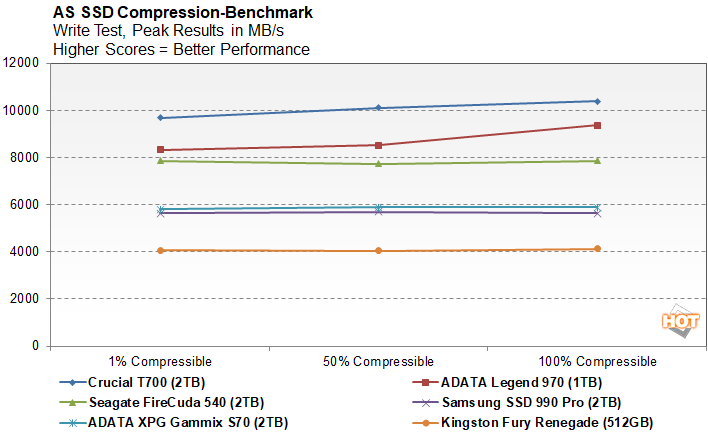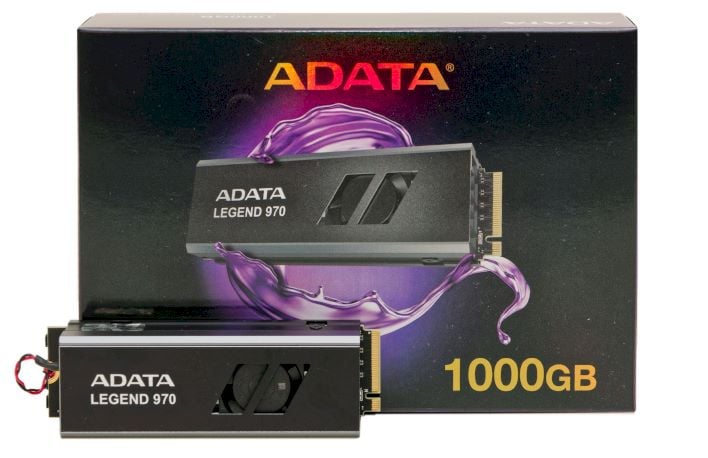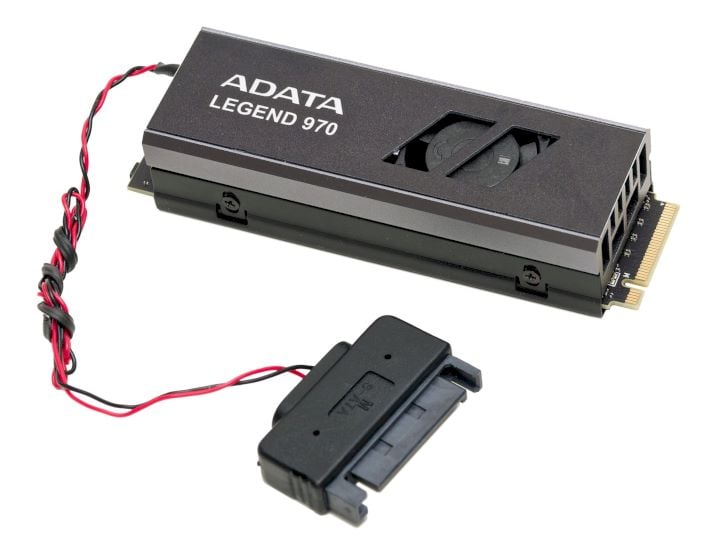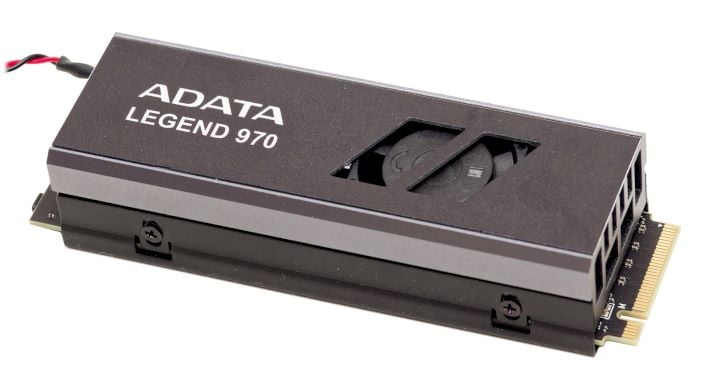ADATA Legend 970 Review: A Speedy, Actively-Cooled Gen 5 SSD
ADATA Legend 970: Actively-Cooled, Speedy PCIe Gen 5 Storage For Desktops
| ADATA Legend 970 PCIe Gen 5 SSD: Currently $339 (2TB) The
|
|||

|

|
||
ADATA Legend 970 SSD Specifications And Features
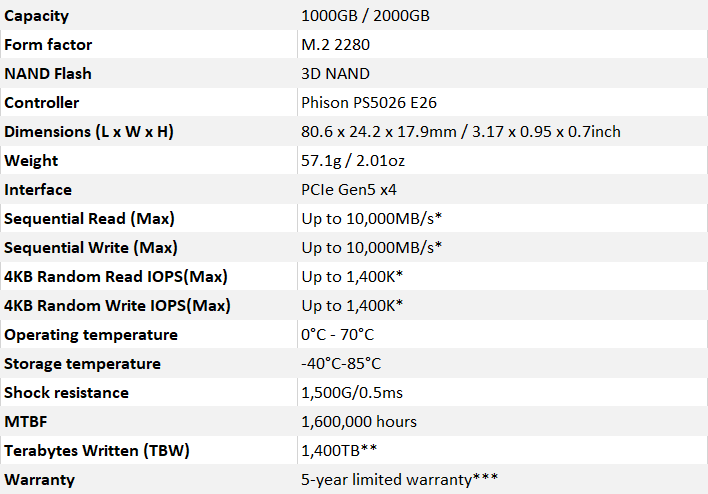
Find The ADATA Legend 970 PCIe 5 SSD @ Amazon
Yep, that's a SATA power connector hanging off the heatsink. Just like with the Phison E26 reference platform that we looked at before, the ADATA Legend 970 includes active cooling. It would be easy to look at this as a failing of the ADATA drive, but the correct perspective is that ADATA is simply making sure that your SSD gives its full performance at all times. E26 drives run hot, and Phison actually recommends active cooling, even though very few of these drives include it.
The bottom of the drive bears the sticker with the serial number and other information. We'd like to see this become standard on M.2 SSDs; having the sticker on top impedes cooling a bit, and also makes this information prone to getting destroyed by thermal pads and heat. The "Warranty Void If Removed" marker is not valid in the United States, but perhaps it applies in other territories where these drives are sold.
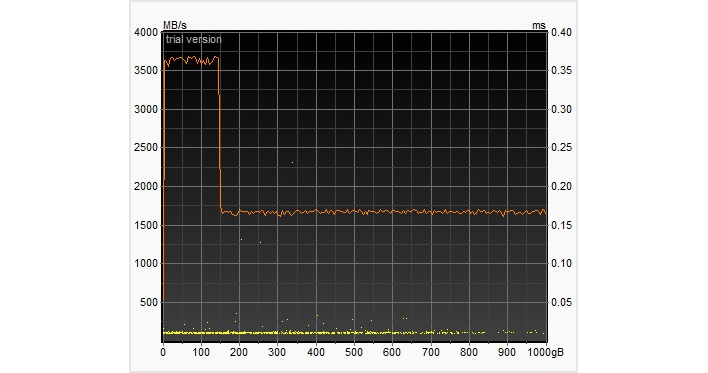
ADATA Legend 970 SSD Benchmarks
Under each test condition, the SSDs showcased here were installed as secondary volumes in our testbed, with a separate drive used for the OS and benchmark installations. Our testbed's motherboard was updated with the latest BIOS available at the time of publication and Windows 11 was fully updated. Windows firewall, automatic updates, and screen savers were all disabled before testing and Focus Assist was enabled to prevent any interruptions.
In all test runs, we rebooted the system, ensured all temp and prefetch data was purged, and waited several minutes for drive activity to settle and for the system to reach an idle state before invoking a test. All of the drives here have also been updated to their latest firmware as of press time. Where applicable, we would also typically use any proprietary NVMe drivers available from a given manufacturer. When not available, the drives used the Microsoft driver included with Windows 11.HotHardware's Test System:
| Processor: Intel Core i9-13900K Motherboard: MSI Z790 Godlike Video Card: GeForce RTX 3080 Memory: 32GB Micron DDR5-6000 Storage: ADATA XPG GAMMIX S70 Blade (OS Drive) ADATA XPG GAMMIX S70 (2TB) Seagate FireCuda 540 (2TB) ADATA Legend 970 (1TB) Samsung SSD 990 Pro (2TB) Corsair MP700 (2TB) Crucial T700 (2TB) |
OS: Windows 11 Pro x64 Chipset Drivers: Intel v10.1.19284 Benchmarks: IOMeter 1.1 HD Tune v5.75 ATTO v4.01.01f AS SSD SiSoftware SANDRA CrystalDiskMark v8.0.4c x64 Final Fantasy XIV: Endwalker PCMark 10 Storage Bench 3DMark Storage Tests |
IOMeter Benchmarks
IOMeter is a well-respected industry standard benchmark. However, despite our results with IOMeter scaling as expected, it is debatable as to whether or not certain access patterns actually provide a valid example of real-world performance. The access patterns we tested may not reflect your particular workloads, for example. That said, we do think IOMeter is a reliable gauge for relative throughput, latency, and bandwidth with a given storage solution. In addition, there are certain highly-strenuous workloads you can place on a drive with IOMeter, that you can't with most other storage benchmark tools. In the following tables, we're showing two sets of access patterns; a custom Workstation pattern, with an 8K transfer size, consisting of 80% reads (20% writes) and 80% random (20% sequential) access and a 4K access pattern with a 4K transfer size, comprised of 67% reads (33% writes) and 100% random access. Queue depths from 1 to 16 were tested...

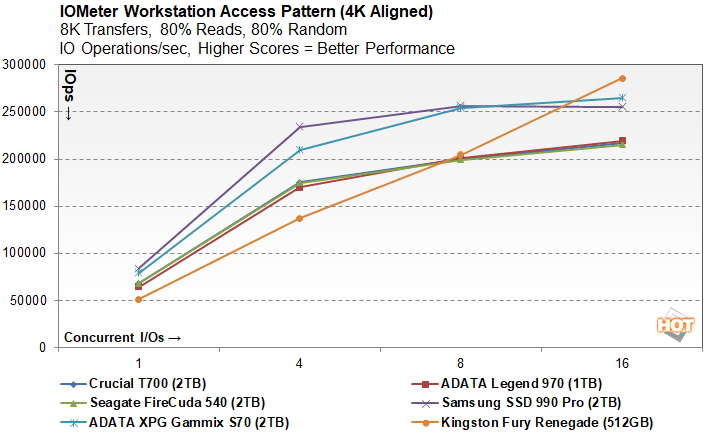
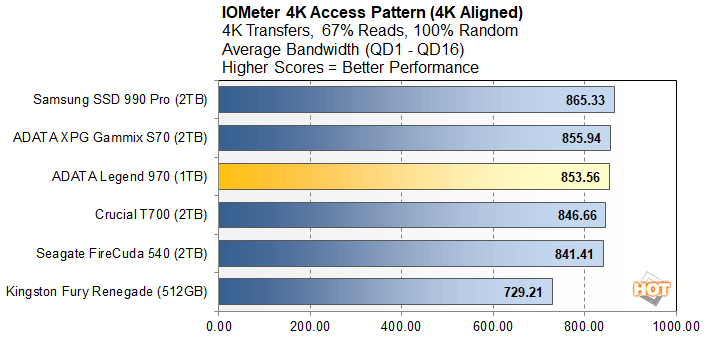
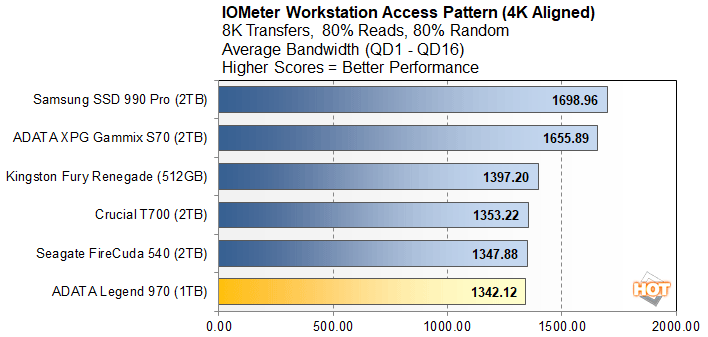
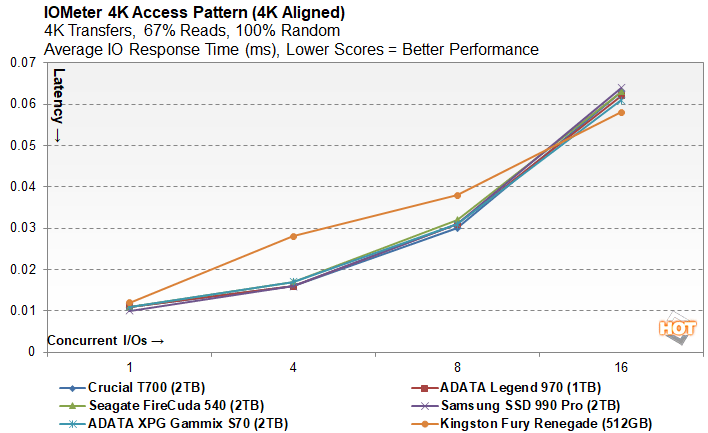

These latency tests basically represent the same data as the throughput tests above, just reversed. That's not necessarily the case exactly, but in this example, it is. The IOMeter Workstation Access Pattern test is punishing, and it's no surprise that the late-gen PCIe 4.0 drives outperform here given the emphasis on rapid response over peak throughput.
SiSoft SANDRA 2022
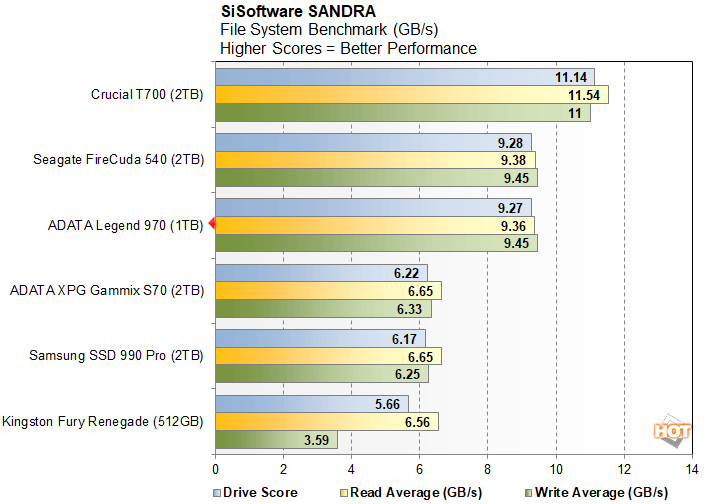
ATTO Disk Benchmark
ATTO is another "quick and dirty" type of disk benchmark that measures transfer speeds across a specific volume length. It measures raw transfer rates for both reads and writes and graphs them out in an easily interpreted chart. We chose .5KB through 64MB transfer sizes and a queue depth of 6 over a total max volume length of 256MB. ATTO's workloads are sequential in nature and measure raw bandwidth, rather than I/O response time, access latency, etc.
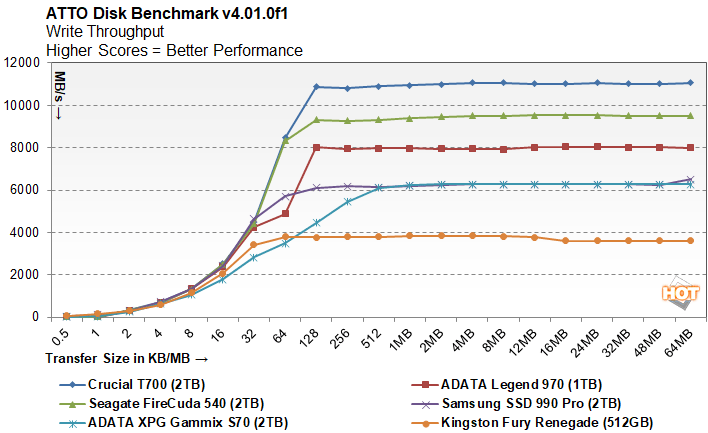
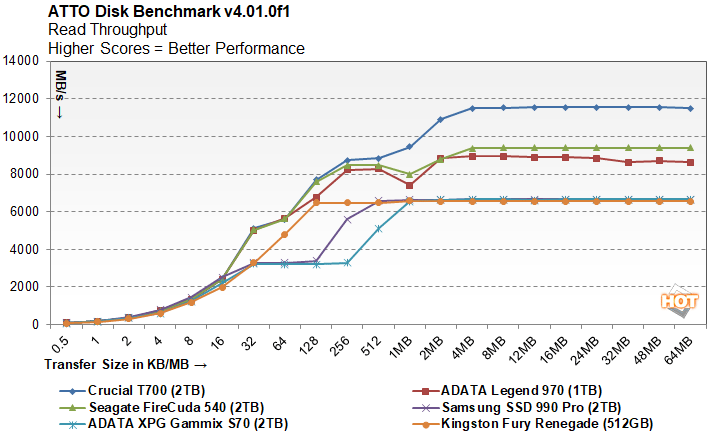
In ATTO, the ADATA Legend 970 loses a bit of ground against the Seagate FireCuda 540, but neither drive can keep up with the Crucial T700 once the transfer size gets big enough. Crucial's drive just runs away from the pack, much like we saw in the SANDRA test above.
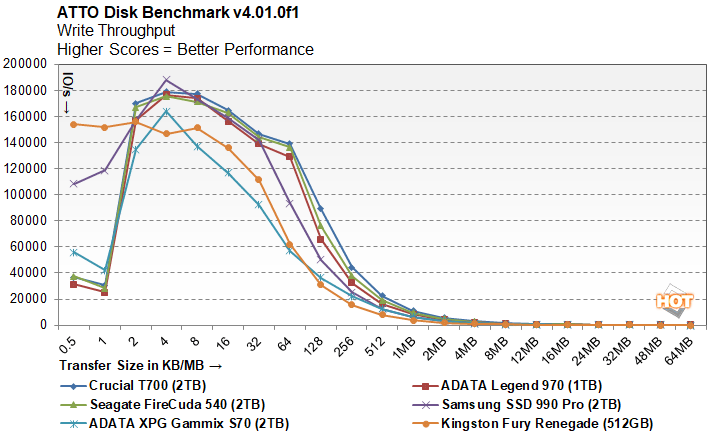
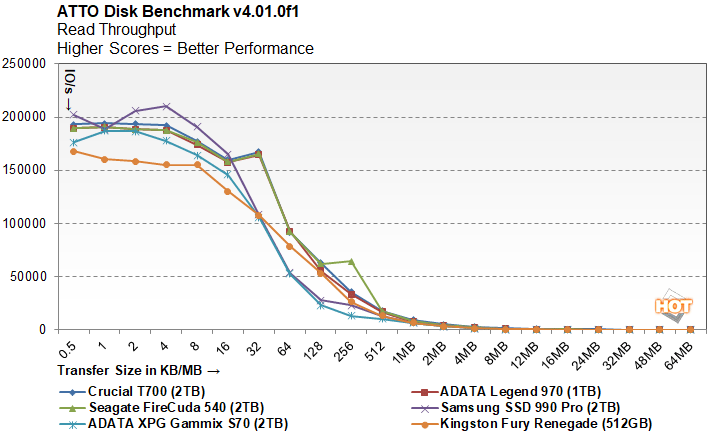
Where the XPG Gammix S70 was able to hang tough with the Samsung SSD 990 Pro in IOMeter, it struggles here, and both drives ultimately get left in the dust when transfer sizes grow enough that the PCIe 5.0 drives can flex their current-generation muscles. The performance of the three E26-based drives is very similar here, as you would expect. The differeces are mostly margin of error in this test.
AS SSD Compression Benchmark
Next up we ran the Compression Benchmark built-into AS SSD, an SSD specific benchmark being developed by Alex Intelligent Software. This test is interesting because it uses a mix of compressible and non-compressible data and outputs both Read and Write throughput of the drive. We only graphed a small fraction of the data (1% compressible, 50% compressible, and 100% compressible), but the trend is representative of the benchmark’s complete results.

